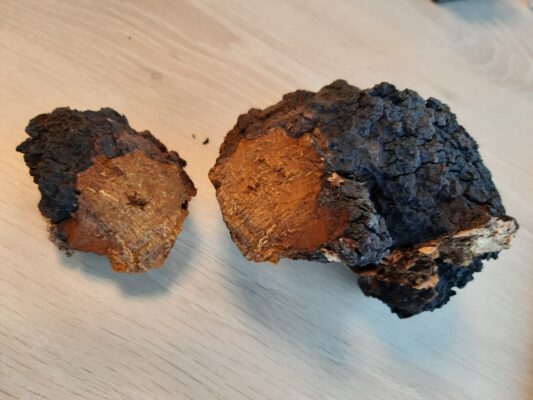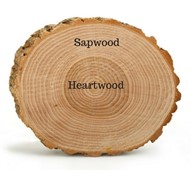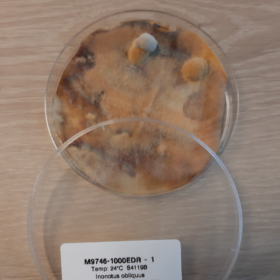Mycelium for professionals
Mycelium for professionals
When you search the internet for a conclusive answer to your question whether or not Chaga Mushrooms (also called “Inonotus obliquus” in Latin) kill their host tree, do you ever find yourself getting lost in the overload of (mis)information?
Well, I’m here to help you out. Because a lot of the information about Chaga mushroom on the world wide web consists of hearsay that is misrepresented or wrongly understood by a small number of sources and which, unfortunately, is adopted blindly. The result is that debunked claims continue to circulate.
So let’s clear things up once and for all.

Chaga spores occur naturally in a large part of the Northern hemisphere, including European boreal forests. The wind carries them around as they try to find a suitable host to inhabit. Floating through the air, they swipe left and right, hoping to find a match. But what makes a tree the perfect mate for Chaga spores?
A healthy tree has a natural defence system against these fungi, which makes it an unfit host. Chaga spores can only infect trees that were previously damaged, for example by the wind, or frost bite. It’s a cliché, but for a successful commitment, it’s the inside that counts.
After infecting such a flawed tree, it will show no outward signs of contamination for the first 3 to 10 years. Not until the sterile conk appears at the area of infection. The term “sterile conk” means that this is not a fruiting body, i.e., not a mushroom, so it does not produce spores.

The fungus “spreads throughout heartwood, but does not penetrate the sapwood, except for the small portion around the sterile conk“. The infection “will continue living inside a host tree for 10~80+ years”. (Source Jankovsky et al. 2008).
There is not much information on whether the Chaga is beneficial or detrimental to the host tree during this long period of time.
But there is little to no evidence that the fungus structurally weakens the tree while it is spreading in the heartwood. It is generally recognized that “infected trees grow for many years without various symptoms of decline” (Source Jankovsky et al. 2008).
So is it detrimental to trees? No, it seems to have little to no effect. Is this result 100% conclusive? No, more monitoring and more research will be needed to be 100% sure. But we are sufficiently sure to allow natural plantations of Chaga in our boreal forests.
The favourite host of Chaga are birches (Betula div. sp.). The most common Betula spp. are B. platyphylla, B. pendula, B. davurica, B. ermanii, and B. costata (Source Ryvarden and Gilbertson, 1993).
According to the European Atlas of Forest Tree Species, a birch tree can reach the age of 90 – 100 years. The Silver Birch, one of the popular birches in the boreal region, is said to have a lifespan of 60 to 80 years. Taking into account that a tree must reach a certain size before it can be infected, it is uncertain how much effect Chaga has on the lifespan of infected birches.

Once the tree dies (from causes often unrelated to the fungus), the Chaga mushroom forms a single fruiting body on the outside of its host to produce spores. You will rarely see this fruiting body because it lasts only a few days before insects eat it.
This means that the time period in which the Chaga is infectious is very short. In addition, the risk of infection is limited to trees already affected by storms or heavy frosts, as we saw earlier.
So, there is no reason to believe that purposefully introducing Inonotus obliquus in boreal forests will lead to a problem, as it is a native species that can only produce spores during a limited time frame. Especially in a plantation, it could be a solution to chop the trees and use the wood before the fruiting bodies appear.
If you want to grow your own Chaga Mushroom, you can order your Inonotus obliquus mycelium here on our website. We have selected very fast and powerful species for industrial production.
Would you like to know more about these and other mushrooms? Sign up for our newsletter and stay informed when we post new articles on the website.
Useful source of information on Chaga’s lifecycle: Introduction to Distribution and Ecology of Sterile Conks of Inonotus obliquus. Department of Life Science, Dongguk University, Seoul, Pages 199-202 Min-Woong Lee, Hyeon-Hur, Kwang-Choon Chang, Tae-Soo Lee, Kang-Hyeon Ka & L. Jankovsky. 2008.
About us
Mycelia is a biotechnology company that produces your mycelium at different stages of development: mother cultures, mother spawn and spawn. Our spinoff Mycelia Academy can assist you with consultancy and training. Our R&D department Mycovision can help you develop your products for the mushroom industry or biocontrol market. Read more
SIGN UP TO OUR NEWSLETTER
Receive updates about mushroom spawn and research innovations.
Proud organisers of the WoodFungi Conference